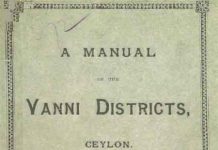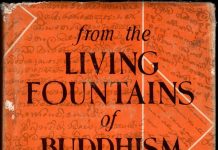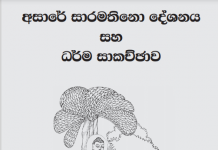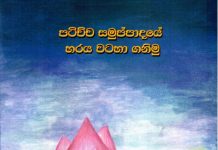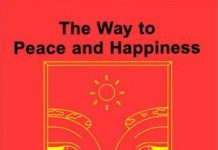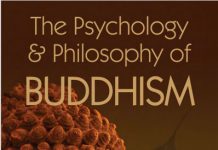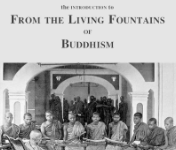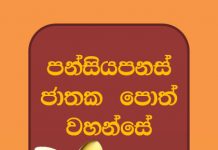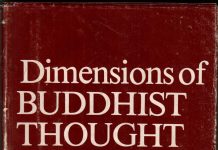2002 Report of the Presidential Commission on the Buddha Sasana
Chapter 09
Conversion of Buddhists to other religions
*translated from Sinhala
9.1 Currently in Sri Lanka, there are followers of four main religions, viz. Buddhism, Hinduism, Islam, and Christianity. There are historical reasons that account for this.
9.2 Historical sources bear witness that many belief systems existed in Sri Lanka and in India when Buddhism was officially introduced at the time of King Devanampiyatissa. Buddhism, which was so sensible, became popular among the people of Sri Lanka, and by the and 5ü centuries Anuradapura became the centre of Theravada Buddhism. Sri
Lankan Buddhists have protected this proud state up until now.
9.3 Various influences contributed to the establishment of South Indian Tamil settlements and to the presence of Hinduism in various places in the country by the end of the Anuradapura Era. These influences include a marriage to a princess from south India,
Indian invasions, and the fact that some Sinhalese kings hired mercenaries to capture kingdoms and to retain power.
9.4 By the 14th and 15th century, Muslims and Arabians dominated the Indian Ocean spice trade. The geographical environment of Sri Lanka made it an important sea trading centre. This caused Muslims and Malay people from the Arabic world, as well as Southeast Asia,
Malakka, and Java, to establish their settlements in Puttalam, Chilaw, Beruwala, Waligama, and Hambanthota. These people married Sinhalese women and those women were eventually converted to Islam. Because of trade, these people went into the interior
parts of the country and established settlements. Muslims who engaged in trade in coastal areas were severely intimidated by the Portuguese. So about 4000 Muslims were chased away from western and southwestern coastal areas. They went to King Senaratna (1604- 1634) and made the king aware of their sad plight. The king temporarily allowed them to stay in Deegawapi and to engage in their trade. There was a harbour there called “Deegamandala Thitta,” where the exports and imports for the king were done. This
harbour could be either the stone harbour which is today called “Kallaraya,” close to “Kalmunai” (embankment), or at Batticaloa. King Senaratna destroyed the fortress at Deegamandala Thitta and this suggests that the Deegawapu colony spread to the Eastern
coast at that time. This is how Muslims were given settlements in the East. But they were not given any right to the land by the king.
(Medhananda, Ellawala (2001) “Buddhangala Loku Hamuduruwo”- Felicitation volume,
pp-90.)
9.5 In 1505, when the Portuguese invaded the Island, Sinhalese Buddhists, Tamil Hindus Of South Indian origin, and Muslims and Malays Of Arabic and Javanese origin were already established on the Island. These people, who happened to live in different parts of the
Island for historical reasons, accepted the sovereignty of the Buddhist king as the head of Sri Lanka. There was no religious conflict and at the time of the Kandyan Era, Hindu kovil became a component Of the Buddhist temple. By about the and centuries, as in India where Buddha was considered to be the apparition of the god Vishnu, an attempt was made to assimilate Buddhism into Hindu civilization. So too in Sri Lanka Hindu gods were assimilated into Buddhist civilization. Therefore, no need arose for Buddhists and
Hindus to change their religions, as Hindu gods became the gods of Buddhists. Up until the time Of the arrival Of the Portuguese, no external interference occurred in the international trade of the Muslims. Hence, for their part, they did not interfere in political issues on the Island. But when their position was challenged by the appearance of the Portuguese, they changed their stance. Muslims tried to retain their identity as Islam adherents. Every woman they married happened to convert to Islam, but it was not an organized process Of religious conversion.
9.6 The European arrival made a velY significant impact on Sri Lankan history. The Portugese, who held the principle of converting the inhabitants into Roman Catholicism, represented the first European nation to land in our country. The Vatican, by a Papal Bull, divided the world into two parts, viz. a western part including America, and an Eastem part which was based on the line of longitude that went across Lisbon. The Western part was given to Spain and the Eastern to Portugal to evangelize. This evangelization process was not always done in democratic ways. Historians say it was done by holding a Bible on one hand while having a sword on the other. The Portuguese tried very hard to make Sri Lanka a Catholic country by baptizing Don Juan Dharmapala, then king of Kotte. In addition, marrying high caste women, fighting against Seethawaka and Senkadagala (Kandy) Buddhist kingdoms (fighting for the kingdom of Kotte), making conspiracies, intimidating Buddhist monks as well as Buddhist people, erecting churches on the debris Of destroyed Buddhist temples and Viharas, and bestowing those who converted with high positions and honorary titles, were all other methods of their evangelization process. Qverose, a Portuguese priest, described the violence inflicted on Sinhalese Buddhists on the basis of the Portuguese documentaries and other sources. He said that the Portuguese lost Sri Lanka, which had every• qualification to be the centre Of a possible Eastern Catholic Empire, as God cursed the Portuguese because of such violence. Those who bore witness to the commission held the view that the dream that existed in the 1+ century to make Sri Lanka the centre of an Asian Catholic empire has reappeared after 500 years.
9.7 In 1658 the Dutch captured the Sri Lankan coastal areas from the Portuguese and in 1797 the English grabbed power from the hands Of the Dutch; in 1815 the whole country became a colony of England. The Dutch, unlike the Portuguese, did not follow a principle of intimidating Buddhists. But conversion of Buddhists into Protestantism
took place in the form of bestowing higher positions and honorary names, establishing Protestant schools, and registering lands which eventually led Buddhists to lose their rights to the land, etc. But, a considerable portion of Buddhists did not convert to Protestantism. After King I Vimaladharmasuwa, the Kandyan kingdom became the centre of Buddhism. The Dutch (unlike the Portuguese) did not marry high caste Buddhist women, and the Dutch intimidated Catholics rather than Buddhists (arising from the then prevailing Catholic-Protestant religious wars in Europe).
9.8 As soon as the Buddhist kingdom fell into the hands of the English empire in 1815, Buddhism and the Buddhist people lost the state protection and favour that they had enjoyed for more that 2, 100 years. This state Of anarchy for Buddhism and the Buddhist people created a favourable background for Christian missionaries. However, in about the 19ü centi11Y the principle of converting people by violent means was changed. Conversion to Christianity was undelway in the form of rewarding higher positions and honorary titles to those who converted, allowing missionaries to act according to their wishes, establishing Christian schools and churches throughout the country, and supporting missionaries who directly and indirectly spread Christianity in the country. At the end of the British era, they sought to produce a dominant English educated social class, and this was a result of the well-planned activity of the English to form a group to be at the service of the Vatican, the Church of England, or various other denominations to continue the process Of evangelization even though colonization was over.
9.9 The fact that Sri Lanka became an independent nation was not a unique event. After the Second World War, political colonization was dying off, resulting in the emergence of politically independent nations in the world. In that context, infliction of conversions through violence was not possible. In order to review this newly created situation, Rome conducted the second Vatican Council from Il Oct 1962 to 8 Dec 1965. Preliminary studies for this council were started in 1959 for about 4,000 bishops representing almost all the countries in the world. Those bishops were bound by a pledge to cany out the
decisions taken up during the council.
9.10 In terms of evangelization, the second Vatican Council can be considered to be a significant milestone.
- One decision is “following a consolatory principle with other Christian denominations and developing a friendly relationship with all the Christian congregations in the evangelization process.”
- About other religions, the council maintained “a new link called ‘dialogue’ should be established” and for this purpose a secretariat for non-Christians was set up. That secretariat has issued a statement as to how to act regarding the non- Christian religions in each country. This new adjustment has advocated not
looking down upon these religions, but instead, considering teachings that do not go against the basic Christian faith (or god—concept) as the gospel.
So Christians and Catholic priests have staffed to learn Buddhism. It has been made compulsory to study Buddhist books like “Dhanunapadaya” at National Catholic seminary• in Ampitiya, Kandy. Buddhist monks are invited and thereby Buddhism is being studied. In parallel, they have started to use things that belong to the Buddhist
heritage like words, customs, methods of meditations, different types of rituals, chanting styles, and Buddhist styles of architecture. All these are no more than sub-components of the evangelization process. Special attention has been paid to realistic Buddhism as it
challenges this process.
9.11 In addition, steps are being taken to establish the concept of Christianity tlrough international institutions such as the World Bank and the United Nations Organizations (UN). Further, necessary international laws have been imposed to condemn, under violation Of human rights, any country that tries to manage the evangelization process. Stmctural changes have also been established in such instances to impose various economic embargoes. At times, attempts were made to include such statements in newly created constitutions. Western Christian countries provide ready political protection for this social process and the governments of third world countries are silenced in regard to the process Of evangelization through the provision Of economic and Other aids. Also, with the help of “humanitarian” non-governmental organizations (NGOs), the process is underway to establish internal Christian-friendly governments. When that is not successful, attempts are made to destabilize or to expel the existing governments. As is the case in Vietnam and Cambodia, direct actions are taken to establish Christian- friendly governments. South Korea can be pointed out as an example of a country where this process achieved success. Governing authority as well as the power to handle the economy of the country has been placed in the hands of Christian Koreans. The percentage of population which is Buddhist reduced rapidly and now it ranges from 20 to 30 percent. South Korea became the prime place in the process Of evangelizing Asia.
9.12 The political powers of Islamic countries have been increased as a result of the development of an oil economy in the Middle East since 1970. As Islamic extremists came to the frontiers of safeguarding their economy from the western countries, such fights were turned into a Jihad massacre. Countries like Iran, Iraq and Liberia have taken key positions in this massacre. It was only an indication Of the possible threat Of Islamic extremists to Buddhism and Buddhist civilization when the Taliban destroyed huge Buddha statues in Bamyan Afghanistan. Here we can see a very significant historical event because countries like Afghanistan, Pakistan, Bangladesh, Malaysia and Indonesia were once Buddhist countries.
9.13 Internationally, the Islamic impact on the world is felt in numerous ways. These Muslims have been able to influence even the economies of developed countries by the “petrodollar,” earned out of the oil industry in the Middle East, in the form of investing money in the share market. Islamic cultural centres are being established throughout the world with the purpose Of spreading Islam. Activities like making the governments Of non-Christian countries unstable, building new mosques or enlarging the existing ones, translating the holy Koran to each country’s language and spreading it among the
people, offering scholarships to enhance the educational status of Muslims, giving aid to establish educational institutions and universities, establishing Islamic banks, and separating Muslims according to their age groups to preserve their identity are being done in the world. In ceftain countries, terrorist organizations like Al Qaeda and Jihad are functioning openly. They go against every Non—Islamic religion by politically making the stable governments unstable, to carry out their purpose.
9.14 Any attempt of studying and finding solutions on Buddhist conversion in Sri Lanka, especially after 1965, should be done in light of the background that we have been discussing so far.
Present situation of Sri Lanka
9.15 What the Roman Catholic Church, Protestant churches and Church of Ceylon could not do in Christianizing the Buddhist people flu-ough 500 years is being done rapidly by evangelical Christian organizations after the independence. Attention has been drawn to
the following precepts found in Bible courses and used by home-to-home missionaries.
- The holy kingdom of Moses is to come velY soon and the whole world will succumb to its power.
- In order to be prepared for that, one should follow Jesus.
- The Bible is the pinnacle Of faith and provides divine guidance.
- The Bible is the basis for understanding the whole world.
- Education should be done through the Bible.
- Embracing Christianity leads to all-round success or total well-being.
9.16 On the advice Of the Vatican and with international assistance, these precepts are being implemented in converting Buddhists into Christianity. There is much evidence to prove this:
- Cardinal Joseph Tomco, who was the head of the mission of converting the whole world, participated in a seminar held on 22 — 29 July 1990. According to the front page article in “Messenger,” the weekly newspaper published by the church, on 14 October 1990, the purpose of the seminar was to revise the missionary responsibilities of the present Sri Lankan and Asian priests and to set suitable strategies.
- A letter written and signed by Pastor Vergis Chand, who was the pastor in charge Of “Light House” situated in ‘Piachaud Garden,’ Kandy, states this: “There are only 4,000 days before the year 2000. We sincerely believe it is harvest time in Sri Lanka”
- Dr. Lallith Mendis of “Christian Ministry Organization,” writing a letter to the monthly magazine “Direction” (on Aug 1987), identified 6 categories Of people who were not subjected to the evangelization process and he suggested the need of special attempt on them. Those identified included citizens of model villages (Adharsha Gammana) and newly created colonies, newly established villages under the Mahaweli scheme, the displaced, prisoners, drug addicts, educated Buddhists, people who live in slums, Muslims and Malay people, Plantation Tamils, fishennen, Chandalas (outcast people), gypsies and Veddha people, urban slum people, university students, prostitutes, army personnel and terrorists.
Appendix 9.2 - Mr. Godfri Yogaraja, the secretary of the National Christian Evangelical Alliance Of Sri Lanka, in his message to mark its Golden jubilee, said (on 24 June 2001): “The Alliance has weathered many a storm and come through stronger in its
commitment to transform this nation for Jesus Christ. It has been a journey of faith, a stow of Grace, a flame that could not be extinguished, and a dream that would not die.” (Newsletter ofEAS1„ LEADS and ESCAPE, July 2001 Volume 1, Issue 1) - The centre Of Radio Bible Class Ministry is situated at Dehiwela, Colombo. This centre is going to be the centre Of RBC ministries in Asia, the Middle East and Africa to spread Christianity in these regions.
- According to Dr. Alex J. Smith, “Thus, the challenge to the Church of the 21 century is to sacrifice through patience, perseverance, and purity of life in order to reach this large remaining Buddhist bloc. Here is a call to pray, to go, to send, to evangelize and to plant churches among Buddhist peoples of Asia. OMF has
worked among Buddhists for the last 135 years. Join us in advancing the gospel to them in the next century.” (From: Asia’s Millions, OMF International, Spring 1999).
Conversion into Christianity
9.17 Mr. Lewis Rambo has pointed out in his book 6 methods for converting the suggested groups. They are as follows:
- Intellectual conversion.
- Making people marvel at extraordinary visions and voices.
- Attracting people through literature distribution such as books.
- Being merciful and full of life.
- Holding shows and attractive speeches.
- Using forceful methods.
(Rambo, Lewis R. Understanding Religious Conversions. Yale, New Haven: University Press, 1993, pp. 14-15.)
Opportunities to convert someone to Christianity
9.18 Christian Missionaries make use of many opportunities to convert people, and they are as follows:
- Poverty
- Unemployment
- Social injustice
- Personal quarrels
- Love affairs and marital relationships
- Physical and mental disorders
- Refugees of terrorism
- People’s desire to get their children entered into highly recognized schools
- The idea of achieving higher positions if converted to Christianity
- Providing opportunities to act freely to oppose Buddhist culture
- Drug addiction
Numerous organizations that convert Buddhists into other religions
Special attention should be drawn to fundamentalist groups who are converting Buddhists under the guise of social work. By March 2002, 110 such fundamentalist Christian groups were registered in the Department of Company Registration.
Appendix 9.3
9.20 There are no individuals or governing authority to inspect or monitor the activities done by these organizations that come from the United States, Western European countries and South Korea. The fact that the activities of NGOs have not drawn the attention of the Ministry of Buddha Sasana or any relevant authorities has encouraged the above-mentioned NGOs to carry on their activities without any problem. Buddhist organizations including prelates Of sects of bhikkhus (Asgiri, Malwathu, Amarapura, etc.) have explained this to the government, but it has borne no fruit so far.
9.21 It is seen that these NGOs have lined up to destroy Buddhism in the last few decades. World Vision Lanka is one such NGO. The full name of it is World Vision Christian Organization. This is an International Christian Organization, which is said to provide aid to under-developed countries. They seek to include evangelism as a significant component of every social work they undertake. The statement of the president of World Vision makes this point clear. “We analyse every program we undertake to make sure that within
that program, evangelism is a significant component. We cannot feed individuals and then let them go to hell” (Ted Engstrom, President, World Vision. Lords of Poverty, 1987, p. 9)
9.22 The presidential commission on NGOs, appointed in 1994, repolted that World Vision converted 50 Buddhists in the Udavalawe area and 100 Buddhists in the Kakirawa area. The commission describes “the mustard movement” that was designed to convert
Buddhists into other religions.
Appendix 9.4
9.23 They settle or “plant” outside Christians among the Buddhists in rural areas. Then, under the guise of social service, they build a close relationship with the Buddhist inhabitants there and systematically convert them into Christianity.
A church/ a congregation/ a prayer centre (or an oratory) in every village
9.24 “Unreached Peoples Of Sri Lanka,” an article written by Dr. Lallith Mendis, states this: “There are 25,487 villages in Sri Lanka. There are 4()() prayer centres in which the congregation assemble weekly. Out of them, 350 are situated in town, while 50 are in mral areas. Our aim should be to “plant” a church in every village.”
9.25 That article speaks about procedures that should be followed when building a rural Church:
- An urban Church should have a Christian person settle in a selected village.
- When it comes to building a church next to the existing village, (we) should be careful. Transportation in rural areas is difficult.
- Several procedures should be followed when building a church in a village.
(i) Settle as an average inhabitant in that village.
(ii) If there is a faithful family, start praying in their house.
(iii) If not, settle a faithful family into the village and then start praying in their house.
(iv) Use avenues such as distributing handouts in house-to-house propaganda. - If the servant of God is an urban person, he should become accustomed to nural life. If his house is made out of coconut cadjan as the houses in other villages are, so much the better. Have a bath in the village common well. Get involved in shramadana campaigns and funerals and to’ to open an avenue for evangelization in this way.
- The hut made out of coconut cadjan is sufficient for the congregation. Villagers often object when big buildings for churches are built. Refrain from keeping crosses or religious symbols outside that outsiders might see.
- If evil power is not chased away or expelled, God’s coming is disturbed.
- It is always useful to give something when casting out evil powers (by the power of the Holy Spirit), as Sri Lanka is subjected to evil power.
- (You) should be able to train a group of believers to manage the congregation.
- Rural Buddhists desperately need a living saviour. The conversion mostly takes place by providing the daily needs of these people, not by faith.
- Be careful when conducting meetings in open areas.
- Strengthen new believers by assigning them to Christian families. Their relatives might object to this. There is a possibility that evil power might take them back to the dark.
- Misunderstanding has occurred in offering money and other aids in conversion. Therefore, have the aid distributed among family members once the confidence is secured.
- In the village, select new families and families in which a non-Buddhist member is living. Avoid living close to a temple or a Vihara.
- Rural and poor churches should be helped by reducing the additional expenditures of the urban churches.
9.25 The following is oral and written evidence presented to the commission by the public about evangelization, and the building of churches and oratories or prayer centres:
- In a village called Wagowwa in the Minuwangoda area (in which 98.5% are Buddhists), a preschool, which was later turned into a prayer centre, was built close to the Buddhist temple called ‘Vivekaramaya. ‘ The Magistrate court of Gampaha passed
a sentence not to pray in this centre. But still, prayers are being conducted on Sundays.
(i) Katunayaka: In Walana, in which 98% are Buddhists, building was commenced on a church under the form Of a hostel. Ven. Pallewela Vijitha and the people in the area filed a case in Negombo Court. The court passed a sentence to stop the construction. - Homagama:
(i) In Katuwana, in which 99% are Buddhists, land that belonged to a Buddhist family was taken over by the government. Later, a portion of that land was leased to a church for 30 years in spite of the opposition by the landowner and the area people. There is now a church built amidst Buddhist houses.
(ii) Fundamentalists in this area forcefully entering into Buddhist houses and relate Old religious stories and condemn Buddhist statues and pictures as “symbols Of Satan.” They change the Buddhist beliefs Of the villagers. They sing religious
songs like “our God is not a pit of clay,” and “our God is not a granite or hard stone” to look down upon Buddhist statues and pictures.
(iii) In Rodrigowatta, Godagama in the Homagama area, a church was built by the Protestant church and as a result a large number Of people were convefted. - In Polpitigama in the Kumnagala district (in which 100% are Buddhists), a permanent church was built. At present, the village is converted to Christianity. This church has also converted Egodagama and Dabegama, adjacent poor Buddhist villages.
- Monaragala/ Badulla
(i) One Mr. Milton has evangelized the Veddha people of Rathugala — Nilgala, Veddha villages in these districts by conducting a church in a preschool.
(ii) They have identified Monaragala as the least evangelized district in Sri Lanka. In order to change this situation, 12 missionaries have permanently settled down in Monaragala and set up an organization called “Wellassa Kithu Haula” (Christian fellowship in Wellassa) and 4,000 Buddhists have been Christianized now. - Seeduwa: a church has been set up and registered under the guise of conducting a preschool at No 477/1 at Mukalangamuwa.
- Christian Centre at Hingurakgoda: the pastor of this centre had a quarrel with the people in the area. The case NO. 37338 Of the Magistrate court at Hingurakgoda and case No. CA 372/2001 of the Court of Appeal bear witness to this. The Magistrate court has passed a sentence to forbid public prayers in the centre. But after a lapse with some time of silence, the public prayers have staffed once again, to the disrespect of the court, while the police provide 24-hour security.
- Emmanuel Church at NO. 40, Glapotta Road, Nawala: This centre, which is situated in a populated area, was started as Light Centre. The complaints filed so far to the Police station in Walikada, and Municipality Council of Kotte have not drawn attention and the illegal activities of the church are still continuing. The priest who appears as Woodrow Lock is going to purchase the adjacent piece Of land in order to expand his religious activities. Saying that he had paid the advance, he prevents other buyers by using a hired mob.
- Assembly of God Good Faith Church, at No. 36, Old Kasbawa Road, Nugegoda: No action has been taken by the Police and the Provincial Council in regard to the complaints made for last two years by the people in the area about the illegal nature Of and trouble caused by the church.
- Anuradapura:
(i) The prayer Centre at No. 753, Second Lane, New Town, and Anuradapura: This has been built in an area which is said to be a populated area. The people have complained to the police and Urban Development Authority about the legality and destructive nature Of its activities over the last two years. In the meantime, the case (No. CA No 325/2000) in the Court of Appeal filed by the Assembly of God Church is being processed.
(ii) Prayer centre functioning at No 731, 2nd Lane, New Town, Anuradapura: This centre is illegally operating in an area reserved exclusively for public occupancy.
(iii) Prayer Centre of Assembly of God functioning at No. 991/30, 2nd lane, Anuradapura: this is also operating illegally in an area where only public occupancy is allowed.
(iv) The Church at No. 269, “Araliya Uyana,” and Hokandara: The attempt by the Pradeshiya Sabha Of Maharagama to know the objective Of this prayer centre failed. This was built as a “Public Centre.” If it is so, public prayer is illegal. As a result of the activities done here, there have been disturbances, destruction of a quiet environment, misbehaviour by the members, and voice pollution; the people around the area have made complaints to the police, but the police have failed to take any action so far.
(v) “Christian Prayer and Healing Centre” functioning at No. Il C,
Galahitiyawa, and Ganemulla: As a result of disturbances and ethically wrong activities, the people in the area even had to engage in a public protest. It resulted in a strategic temporal silence but gradually the activities began once again. This organization has started small scale meetings in the following houses:
i. No. 296, Horagolla, Ganemulla
ii. No. 435/C, Kuda Bolaththa, Ganemulla
iii. No. 252/E, Mahawaththa, Horagolla, Ganemulla
iv. No. 239/E, 14/2, Perera Mawatha, Horagolla, Ganemulla
v. No. 370/9, Galahitiyawa, Ganemulla
vi. No. 331/2, Sumedha Mawatha, Ganemulla
vii. No. 342/9, Mahathilangamuwa, Ganemulla
viii. No. 57/4, Kandaliyandda, Ganemulla
ix. No. 202/C, Horagolla, Ganemulla
All these places are meant to be normal houses for living. (This information is taken from a chart that is in the house of No. 1 L/C, Galahitiyawa, Ganemulla.)
13 Panadura
i. Panadura – Prayer centre at Malmaluwa, Samarasinghewatta:
The public animosity and complaints made against this centre
are a result of disturbances and the illegality of the centre.
ii. In a normal residential place on Malmaluwa Road, Panadura, a
public prayer service is also being operated.
iii. The prayer centre, operating in a private residence is opposite to
the Army camp, at Kaviraja Mawatha, Panadura: The people in
the area informed the police and the Provincial council
regarding the activities done here, and due to the strong
opposition of the people in the area, all the functions of this
centre were stopped.
iv. “Church on the Rock prayer Centre” at Leo Fernando Mawatha,
Panadura (which is being operated on the consent of the
inhabitants in the area): NO action has been taken on the
complaints and public opposition made to the Provincial
council.
14. Ratnapura/ Abilipitiya/ Kalawana/ Alapathai Ahaliyagoda
In these areas crosses are provided to be hung around the neck of the Buddhist children. If 100 crosses are distributed among children, at least 25 children have them. By giving clothes, books, toys and money, they strategically convert these children into Christianity.
15. Kundasale: Koreans have staffed a golf course, named Rajawatta Company, by purchasing Mahaberitanna farm at Pallekake, Kengalla. The manager has asked the principals of the Sinhela and Tamils schools around the area to send children to pick up the balls. In addition to picking up the balls, biblical classes are held for these children under the guise of teaching English. They have stopped the activities here because of the opposition they faced by ‘WIN’ and the Area Buddhist committee, Kandy. But this may be started once again in the form of an Agriculture centre of Watarappola.
16. Palkumbura: This is a completely Buddhist village. The Kandy Municipal council has given the approval to construct a Catholic Church complex. As the plan is exposed the project is being operated slowly.
17. Kandy: It is seen that many people in the area Of Karaliyadda, Mahakandarawa, and Kengalla have been converted through the evangelization process of the Assembly of God church. Due to the protests organized by ‘WIN’ organization of Kandy, a church started by a Jehovah’s Witness group under the guise of being an aquarium was forced to stop operating at Udakale, Bowala, in Kandy.
18. Rajanganaya: By opening up preschools, they attract Buddhist children. As the chief Buddhist incumbent in the area was informed about this, the project has proceeded relatively slowly.
19. Wanathavilluwa: “World Vision” is gradually operating in the area. They have convefted the youth in the area and now are engaging in converting the chief and old benefactors in the temple. The Buddhist monks in the village temple are now paying attention to this matter.
20. Demalagoda — Horampitiya: A youth who came from Negombo has converted 20 youth in the form of teaching them Mathematics. An invitation has been given to the Buddhist monk in the temple to follow a course in England if he is ready to renounce his faith.
Evangelization through preschool
9.27 At present, preschool education is not conducted by the Ministry of Education. Christian fundamentalists have illegally started preschools for small children in various rural areas. Through them, they to inculcate the concepts Of Jesus into the minds of these Buddhist children.
9.28 Small children are made to sing Christian hymns in the morning and evening everyday. Following is the hymn sung by Buddhist children daily at the preschool conducted by Assembly of God church in a village in Kandy:
“I washed my hands to be cleaned!
I will give them to Jesus to make use of them!
Whither to step my little feet!
I would do it according to Jesus!
I tell Jesus to come to me!
Then I can be a child of God!”
9.29 World Vision Christian Organization has employed female preschool teachers by converting them and paying them monthly to inculcate Christian ideas into the minds of Buddhist preschool children in areas like Kabithigollawa, Horowpathana, Wahalkade, Padaviya, and Sri Pura. Detailed information was revealed in the meetings held in the Young Men’s Buddhist Association – Kumnagala, Bhodhi Arakshaka Hall — Kalutara, Pushpadana Hall — Kandy and Chief incumbent Warikaramaya — Colombo.
Evangelization through providing material and financial aids
9.30 The above-mentioned organizations provide various aids by showing an assumed artificial kindness to the Buddhists. They convert these Buddhists into Christianity by saying that the Buddhist temples do not provide such aids thus making them disappointed about Buddhism. These Christian organizations say that all these aids are from God and if you wish to receive such aids in the future your
whole family should embrace Christianity.
Evangelization through love-affairs
9.31 A popular activity is undervvay by prompting young Buddhist boys and girls to associate and marry young Christian boys and girls. The last aim of this activity is to baptize the offspring to increase the number of their religion.
Evangelization through curing diseases by praying to God
9.32 By using energetic slogans like “At the divine foot” and “Jesus is alive,” and organizing public prayer sewices, hymns and musical shows at Havelock Ground, Colombo, and other places, these evangelical groups tv to internally stimulate the participants and motivate them to change their religion. Example: Open rallies of
curing diseases conducted by Bro. S. Rajendram and Rynehard Boncco.
Appendix 9.5
9.33 These fundamentalists conduct the prayer services in the houses of those who are sick, hinting that they would be cured, and thus turn them into Christians. There is a mention about this kind of conversion in “Evangelical Movements in South Asia” written by Dr Sasanka Perera, page 91. One female who presented evidence to the Commission in Kandy said that her disabled elder brother was promised a cure and his deformity was prayed over to convert him to Christianity, but his condition is still the same.
Evangelisation through the provision of jobs
9.34 Various evangelization activities have been put into action for some time in the form of providing job opportunities to unemployed youth, and especially providing assistance to start types of self-employment that go against Buddhism. Here, the religious conversion takes place by providing assistance to animal husbandry and broiler farms. It is indicated that Buddhist temples do not Offer such
assistance. Evangelization through awakening or motivating the village
9.35 Certain Christian fundamentalist organizations convert Buddhists by promising to develop their village. As examples, World Vision Lanka organization converts villagers in the tropical zone by providing them well pumps, constructing some small houses, giving material and financial aid to preschools, and providing water pumps, fertilizers, etc. to improve their agriculture. People of these rural areas are not in a position to Object to the underlying purposes that come with this
assistance, although they know them quite well. The final aim of this assistance is to convert Buddhists into Christianity.
9.36. The following incident was reported as an example (to the aforementioned activity). “Gannan Fanners School” was started by Catholic Koreans in Watarappala, a Buddhist village in Udunuwara, Kandy, with the approval of the Sri Lanka Investment Authority. But no course on agriculture was conducted here. Further, no agricultural implement was seen. This building was used only for advancing evangelization. Later, as a result Of the interference Of ‘WIN’ organization, Kandy and Buddhist Action Committee, together with the protest campaigns of Buddhist people, the Investment Authority had to cancel the approval of the so-called farmers’ school. The Korean couple who founded it have left, but new Koreans engage in evangelization though continuously conducting Bible classes.
9.37 Evangelization through distributing booklets and hand-outs and various kinds of influence gained by entering homes The following are the fundamentalist groups that engage in such activities:
- Good News Centre
- Rapid Bible Classes
- Ceylon Every Home Crusade
- Our Daily Bread
- Assembly of God
- Youth for Christ
- Grace Evangelical Church
- World Wide Church of God
- Seventh Day Adventist
9.38 Ceylon Every Home Cmsade was started in 1970. The aim in 1995 (that means after 25 years) was “Reach every home in Sri Lanka for Christ.” The organization distributes handouts on Christianity in three languages (Sinhalese, English and Tamil) and they come to houses privately and engage in discussions. In these methods they highlight that the solution for every problem in life is Jesus and in order to solve these problems one should embrace Christianity. Mostly, they select areas in which uneducated rural people live for this process.
9.39 Destroying the faith, devotion and respect the Buddhists have towards Buddhists monks.
These Christian fundamentalist groups strategically use false monks to
engage in behaviours that Buddhist monks should not perform, thus making the Buddhist devotees disappointed with Buddhism. Then they convert these Buddhists.
The Muslim Impact in Sri Lanka
9.40 The world wide Muslim impact is rapidly spreading in Sri Lanka too. Through marriages and the desire to have Middle East jobs, Buddhists are converted into Islam.
9.41 Frequently Muslims illegally occupy the areas belonging to Buddhist shrines. Examples are as follows:
(i) Kungala holy place, Kalthota, Balangoda:
A portion of this shrine, which has more than 100 caves, was given to a Muslim organization due to the influence Of a Muslim politician 9 years ago. A mosque and Muslim houses were built within the lands Of this Buddhist shrine. Ven. Wattaddara Gnanathissa Thero, who lived there in the past, has explained the whole history of this shrine and the injustice inflicted on Buddhists. “Aithihasika Ratnapura” (Historical Ratnapura) compiled by Mr Bandula Liyanage, shows explicitly the existence of Buddhist civilization at the Kuragala shrine. Today, talking about this shrine is a total disaster. This holy area, now turned into a mosque, is called “l)hantha Jeilani.” Buddhists are terribly upset over the killings of animals taking place in this place where, it is said, in the past Arhats used to have their alms.
(ii)Potuvil Sea Viharaya: This is considered to be the place where Viharamaha Devi (Mother of king Dhutugamunu) landed. In 1967, the Sri Lanka government donated 32 acres over a gazette paper. But to date, Muslim houses are seen even within the lines Of this shrine. Only about 8 areas now belong to the shrine.
(iii)Deegawapi: For the well-being of this sacred place, past kings in the country donated 8,000 acres. But to date, this shrine possesses only less than 600 acres. There are even two mosques at the side of the road leading to the shrine. Lots of Muslims are living around this area.
(iv) Rakwana: Hundred Of years ago, there lived only Buddhists at Raknvana. Muslim and Tamil invasions have made the Buddhists now third in number. Lots of land and business that belonged to Buddhists then are owned now by Tamils and Muslims.
(v) Katugastota: Muslims initially bought the land and then turned it into a preschool, and in the end it was made a mosque. This strategy is used Island-wide. Rahula Vidyalaya, Katugastota, is a 115-year old Sinhalese school. Now a mosque is being constmcted on a poftion of its land by purchasing it. Although Buddhist organizations in the area protested against this, they were not successful.
(vi) Gampola: In a square-acre in the Gampola area, there are 32 mosques. Most of them have been built on the lands that belonged to Buddhists.
(vii) Kandy: At Dheiyannewela (etymology Of the name Of this village is “the paddy field that provided rice for the king whom people called god”), Muslims tried in 1988 and 1992 to build a mosque, but failed due to the strong opposition of the Buddhists of the area. But Muslims, once again, tried to build it. This is a Buddhist village. At the moment also, there are number of mosques for the Muslims who live here. Now this situation has led to the point of a religious conflict.
(viii) Further, the commission has reported that there is an attempt to convert Buddhists who work in the Middle East by various influences and by distributing small booklets on Islam in Sinhala.
9.42 The commission has reported that Muslims as nations and Christian fundamentalists as religions are engulfing our country.
9.43 Therefore, in most of the districts the percentage of Buddhist population has been reduced as a result of a systematic, strategic and well-planned evangelization process. With this, the percentage population of other Christian churches, except Roman Catholicism, has
increased. In most districts, the Muslim percentage has also increased.
9.44 The following is an extract from the report issued by Department Of Census and Statistics in 2001 showing the increase of Christians:
9.45 When comparing the census reports Of 1981 and 2002,
Buddhist population has been reduced.
Example:
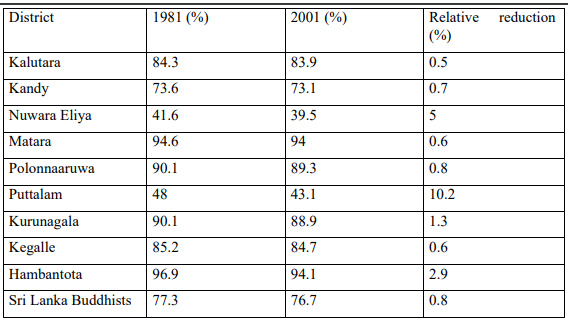
9.46 At the same time, an increase Of the Muslim population is recorded in many districts.
Example:
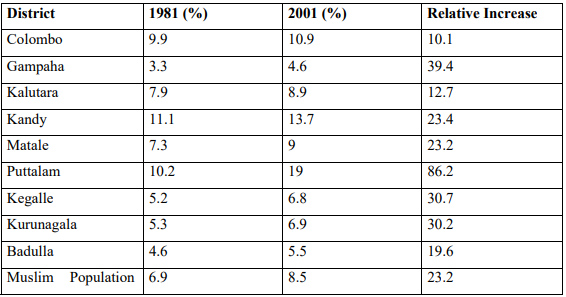
9.47 According to the census of 1981 and 2001, the increase of the population of Christians except Roman Catholics:

9.48 On the whole, during the period from 1981 to 2001, a reduction of the Buddhist population in the country is seen. Muslims and Christians other than Roman Catholics have recorded an increase in the population.
9.49 In order to spread Buddhism and to hand it over to the future generation, the following conclusions and recommendations are made according to the study made based on oral and written testimonies presented to the commission. The commission concludes that, in consideration of that fact that several districts are not included in the 2001 census and that over I million non-Buddhists have settled as refugees in India and Other countries, it will be seen that the percentage of the Buddhist population is remarkably reduced.
Recommendations
9.50 The above-mentioned evidence proves that the conversion of Buddhists into other religions is done in a very strategic and non-ethical manner and that this has led to violence in some areas. The commission states that necessary steps should be taken even now. If not, the commission warns that there is space for the eruption of a religious conflict that could lead to instability Of the state. Recommendations are made separately, as the government, the Buddhists monks, Buddhist organizations and Buddhist people are responsible in this
The responsibilities of the government
9.51 It is seen that the religion of the majority of the people in a country becomes the state religion. Bhutan, Nepal, United Kingdom, certain European countries, and Arabic countries are examples for this. In the Sri Lankan society, this condition prevailed until 1815. In
Malaysia, even though its Islamic population is 52%, the state religion has become Islam. From the Devanam Piya Tissa era to 1815, the state religion had been Buddhism. Therefore, Sri Lanka, in which about 70% are Buddhists, has qualifications to make Buddhism the state religion.
9.52 While the commission recognizes that everybody has the constitutional right to adhere to any religion, it states that it is not suitable to follow infuriating methods like the ones mentioned earlier, i.e. the ‘mustard seed project,’ in the process of evangelization. In the
same way, it is also not good to use money and power to convert people from other religions. Such activities disturb the inter-religious harmony. Further, it also disturbs the harmonious lifestyle Of the people of the country. Therefore, a bill should be introduced to
ban such activities. At the same time it should be considered a violation of the code of law.
Inter-religious advisory council
9.53 An inter-religious advisory council should be appointed with due representation Of all the religions to negotiate any religion-related conflict. If incidents Of one religion’s activity causing disturbance to another are presented to the council, the council should be obliged to
solve it. Preliminuy approval should be sought from the council by any new missionary or fundamentalist organization before being registered. The commission recommends that the members Of this council should be appointed in proportion to the population Of each
religion. It is recommended that the Council of the Buddhist monks or any authority recommended by it should represent Buddhists.
9.54 There should be a detailed description in each Divisional Secretariat about the religious places, prayer centres, preschools, NGOs and various Other special projects. That information should definitely be given to the local Shashanarakshaka Mandalaya (Committee to protect Buddhism). If needed, the Divisional Secretary• should be given due authority to inspect aforementioned places.
9.55 When cases of conversion ofBuddhists to other religions are reported, the authority should be given to the Shashanarakshaka Mandalaya to inspect them.
9.56 Following are the recommendations made by the commission about setting up, constructing, or enlarging new churches or prayer centres.
1. “Buddhism should be protected in this country. Therefore, when building any religious place other than that which is Buddhist, an approval should be sought from the governor who rules the country.” This was the policy when it came to building a religious place during the British era. This statement is included in the sentence Of the British
Sovereign constitution and the chapter of the Sri Lankan constitutional convention. This is still in practice. Therefore, when establishing, constnlcting, or enlarging a new church or a new prayer centre, a government agent should assess its necessity publicly and he should get the approval of the inter-religious advisory council before he approves it.
2. It should be prohibited to turn what initially started as non-religious preschools, hostels, agricultural centres, or community centres into churches.
3. As it disturbs the peace in an area, it should be prohibited to operate churches in private residential houses or halls.
9.57 The commission recommends the following processes when issuing a visa:
1. The government should enact new laws making the respective embassies responsible for issuing visas only for the people who guarantee that their stay in the country will not jeopardize the religious, social, cultural, and economic identity Of the country. Before
issuing visas to the foreigners who come to the country, approval should be secured from the Ministry of Buddhasasana. In extending such visas, too, the approval of the Ministry of Buddhasasana should be secured.
2. The visas of individuals who engage in missionary activities after coming to the country under the guise Of social work should be cancelled.
3. When issuing a visa, the Emigration and Immigration Department should:
(i) Clearly mention the reason as to why the visa was issued.
(ii) Affix a stamp on the visa issued for foreigners prohibiting them to engage in missionary activities.
(iii) Cancel the visa when those conditions are violated.
9.58 Conditions should be included to ban conversion done under the guise of a social service component in the agreement established by the foreign organization with the Sri Lanka Investment Authority. There should be full transparency in the investments and related
activities done as social responsibilities. Annual reports of such activities should be presented to the Investment Authority, and the general public should be given the access to go through them or to have photocopies.
9.59 The warrant Of the organizations that engage in religious conversion under the guise Of social work should be cancelled. Actions should be taken to stop the activities of organizations if they are foreign-based or have direct links with foreign donor agencies.
9.60 The commission recommends that the government should take the following steps regarding NGOs:
- A new system should be introduced to register the foreigners and NGOs that come to the country to engage in social work. The registration should be done after a thorough assessment Of their intended activities in the country and their purposes, objectives,
expectations, and impact to the country. - Suitable actions should be taken to see that funds from the above-mentioned organizations brought to the country be transferred through the Central Bank or any accepted bank. The usage of such money should be under the government’s careful watch. The information on such things should be open to the general public. The annual reports and financial reports of such organizations should be made available to see their transparency.
9.61 At the time Of registration Of missionary or religious organizations, a pledge should be made by them stating that no conversion of people of other religions will be done, only engaging in the benefit of its own people. Conditions should be included to ban an organization if it is proved that they have acted otherwise.
Responsibilities of the Bhikkhus of village temple
6.62 In this regard, the residential bhikkus of temples have a big responsibility. It should be noticed that the success of the conversion of Buddhists to other religions is recorded when the traditional relationship between village and temple has been weakened or broken. Therefore, in order to improve the relationship between the village and the temple, the recommendations Of chapters 4 and 8 will be useful. The following matters are considered once again.
1. Every temple should be the centre of the village. The village leadership that lies at the hands of the chief incumbent Buddhist priest should be strengthened though his activities. Therefore, every temple should try to establish:
- a preschool
- a Sunday school
- a youth sewice centre
- a counseling centre
- an information Unit
- a library and a social service centre
The bhikkhu of the village temple should be especially attentive to the success of the above-mentioned centres.
2. The Bhikkhu should not have a divisive attitude about the village benefactors, and the former should see to the latter’s problems.
3. When a Buddhist gets sick, it is important that the bhikkhu of the village temple should go to the hospital or the house and chant ‘pirith’ (or paritta) to bless the sick person. As there is a special activity of converting the Buddhists who have long-term diseases, the counselling centre Of the temple should avoid such cases. It is greatly
appreciated if the bhikkhu of the village temple assists so that the helpless Buddhists are no longer alone.
4. Strong temple-based social projects should be commenced to gather the male and female youth. These projects should include:
(i) Helping the helpless
(ii) Organizing the sports meets
(iii) Helping people refrain from alcohol and tobacco
(iv) Organizing national ceremonies
(v) Developing the village through shramadana campaigns
If male and female youth are bound to the temple through these social works, the task Of converting Buddhists into non-Buddhists is pretty difficult.
5. The bhikkhu of the village temple should not confine himself to the temple itself. Instead, he should go around the village and see to the benefactors’ religious and social development. Whenever possible, the practice of ‘Pindapatha’ (searching for food) should be done. He should work closely with the village benefactors.
Responsibilities of Buddhist organizations
9.62 The Buddhist societies and organizations should be aware of the conversion Of Buddhists into Other religions and, the commission recommends, that the following actions should be taken:
- As poverty is the main reason for Buddhists to be converted into other religions, Buddhists organizations and well-to-do Buddhists should try to improve the living conditions of such people. In this regard, the Kalutara Bodhi Responsible Committee and Matara Bodhi Protective Committee are fitting examples.
- By including a sentence about working against religious conversion into the constitution, every Buddhist organization should eliminate religious conversion at the village level.
- Every Buddhist organization, when they learn about a case of conversion, should inform the Minist1Y of Buddhasasana and the Shashanarakshaka committees.
- Lots of Buddhist organizations are inactive. They should first be activated and then contribute to the Buddhist renaissance.
9.63 Following are what the commission recommends the Buddhist people should do:
- They should be alert to the conversion of Buddhists to other religions in their area. If such a case erupts, they should inform the chief incumbent of the village temple, the police, Department Of Buddhist affairs and the Ministry Of Buddhasasana about it. In addition, they should inform the powerful organizations that work on this matter.
- In all the relevant occasions, they should complain to the nearest police station about the conversion. Then they should tell the police what to do according to their knowledge. They should buy the paper that contains their complaint. If their complaint is not accepted by the police, they should inform the local Shashanarakshaka Committee. Further, they should inform the Hon. Secretary, Buddhist development council, No 42, Asgiriya Temple, Kandy. Then the authorities will decide as to what should be done.
- The general public should take a key interest in the following, and complain about such:
1. Prayer services that contain great noise and disturb the neighbours.
2. The curing of diseases at the risk ofpeople’s health.
3. Attempts to teach about other religions by coming to houses without the owner’s consent.
4. Things such as teaching other religions to children without the parents’ consent, prayer, putting them in prayer services, motivating youth to engage in non- ethical activities, etc. - If the following situations take place, the Provincial Councils and local Shashanarakshaka Mandalas, and the Hon. Secretary’, Buddhist Development Council, No. 42, Asgiriya Temple, Kandy should be informed.
1. A prayer centre is set up without the permission of the respective provincial councils (such as Pradeshiya sabha, Municipal Council, Mega-Municipal Council).
2. A certain place such as a school or a church or a prayer centre is used without approval.
3. It is attempted to set up a Catholic/ Christian church or a mosque.
9.65 It is the belief Of the commission that when the recommendations Of this commission are completely implemented, the development Of Buddhism will be secured. Sri Lanka is the centre of Theravada Buddhism. It is the duty and responsibility of everyone to preserve it for the future generations. The Government, the bikkus, the Buddhist societies and organizations, and the Buddhist people should work for this because preserving Buddhism in Sri Lanka leads to the development Of worldwide Buddhism. Further, the commission believes that its recommendations do not disturb the constitutional rights of the followers of other religions, while it improves the harmony rather than animosity among people who follow various religions.


